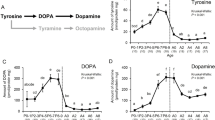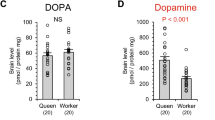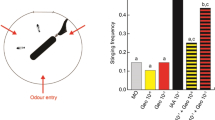Abstract
ROYAL jelly has significance in polymorphic development of bees. Bee larvæ fed on an overabundance of royal jelly develop into queens ; those given food differing quantitatively and qualitatively become worker bees1. Royal jelly has other interesting properties, for evidence is available of its therapeutic value in transplantable mouse leukæmia2 and of the presence of an antibiotic3. These effects might be termed anti-growth properties. It is remarkable that royal jelly is stated to contain acetylcholine4 in an amount calculated to be about six times that found in the brain of insects5. Nothing is known about the origin of acetylcholine in royal jelly or indeed whether this substance, obtainable from bees other than those used by Henschler4, contains acetylcholine. The occurrence of a neurohormone in royal jelly is of considerable interest for it suggests that acetylcholine may have a function different from that associated with nervous transmission.
This is a preview of subscription content, access via your institution
Access options
Subscribe to this journal
Receive 51 print issues and online access
$199.00 per year
only $3.90 per issue
Buy this article
- Purchase on Springer Link
- Instant access to full article PDF
Prices may be subject to local taxes which are calculated during checkout
Similar content being viewed by others
References
Ribbands, R., “The Behaviour and Social Life of Honey Bees” (Dover Publications, Inc., New York, 1953).
Townsend, G. F., Morgan, J. F., and Hazlett, B., Nature, 183, 1270 (1959).
Blum, M. S., Novak, A. F., and Taber, S., Science, 130, 452 (1959).
Henschler, D., Hoppe-Seylers Z. physiol. Chemie, 305, 34 (1956).
Colhoun, E. H., J. Ins. Physiol., 2, 108 (1958).
Smallman, B. N., J. Physiol., 132, 343 (1956).
Goldschmidt, S., and Burkert, H., Hoppe-Seylers Z. physiol. Chemie, 301, 78 (1955).
Author information
Authors and Affiliations
Rights and permissions
About this article
Cite this article
COLHOUN, E., SMITH, M. Neurohormonal Properties of Royal Jelly. Nature 188, 854–855 (1960). https://doi.org/10.1038/188854a0
Issue Date:
DOI: https://doi.org/10.1038/188854a0
This article is cited by
-
Beyond Royalactin and a master inducer explanation of phenotypic plasticity in honey bees
Communications Biology (2018)
-
Isolation and characterization of proteases that hydrolyze royal jelly proteins from queen bee larvae of the honeybee, Apis mellifera
Apidologie (2012)
-
DNA methylation and methyl-CpG binding proteins: developmental requirements and function
Chromosoma (2009)
-
Proteome analysis of Apis mellifera royal jelly
Analytical and Bioanalytical Chemistry (2007)
Comments
By submitting a comment you agree to abide by our Terms and Community Guidelines. If you find something abusive or that does not comply with our terms or guidelines please flag it as inappropriate.



